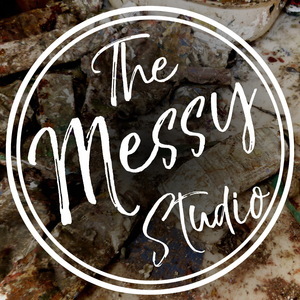Considering Scale
Episode 129 · June 13th, 2020 · 36 mins 50 secs
About this Episode
Scale is an aspect of visual design that is perhaps the easiest to overlook. This is because there is a default mode that generally works—that is, medium sized works of art, and imagery that fits in expected ways within those boundaries. But challenging habitual ways of using scale can be an exciting path. As viewers, we notice immediately when someone steps outside the expected and calls attention to scale. Today we have some thoughts about using scale in dynamic ways.
When considering scale, it's good to consider both the unique aspects of small, medium and large work and whether the scale of your own work is a good fit for your ideas and imagery. Each scale involves you as the creator and your viewer in different ways. How would you like the viewer to be involved in your work--up close or from a distance, or both? How important is boldness or delicacy, and at what scale are those best expressed with your way of working?
There are also practical considerations for each scale. From small work--usually inexpensive to create and easy to store and ship, but often requiring framing--to large work which can be cumbersome, expensive to create, and hard to store and ship. However, larger work also has a higher price point and more impressive presence for the viewer. Finding solutions to practical issues is not impossible though, and this too can be an excercise in creativity.
Many artists use a medium scale for both practical and conceptual reasons. But this size presents its own challenges for the viewer, because on its own it draws no special attention to itself. We are surrounded by objects of similar sizes in our homes and though this makes medium scale fit into most environments, it also may make a painting simply part of the decor rather than something that is set apart and special.
Giving thought to the scale of your work is an important aspect of aligning form and content. Have you fallen into the habit of always working on the same scale? What new ideas or ways of expression might result from pushing the scale at which you work, going either smaller or larger?
Lisa Pressman's Videos:
https://www.lisapressman.net/teaching-videos/
For more from The Messy Studio:
www.messystudiopodcast.com
www.facebook.com/messystudiopodcast
For more from Rebecca Crowell:
www.rebeccacrowell.com
www.squeegeepress.com
